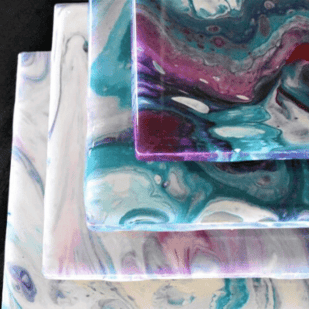I love working with resin, but I wanted to take the time to asnwer the question ” What is resin?” especially in the realm of art, because it’s not the most common of matierals, and it’s important to know what you’re working with. Plus, it’s interesting to know where things come from.
Resin Definition
Resin is generally considered to be a viscous substance that when exposed to certain conditions transforms into a solid. These conditions can be heat, light (usually UV light), or another substance such as a hardener.
There are two classes of resin, those that are naturally occurring and those that are manmade or synthetic.
Merriam Webster defines resin as:
- “Any of various solid or semisolid amorphous fusible flammable natural organic substances that are usually transparent or translucent and yellowish to brown, are formed especially in plant secretions, are soluble in organic solvents (such as ether) but not in water, are electrical nonconductors, and are used chiefly in varnishes, printing inks, plastics, and sizes and in medicine.”
- “Any of a large class of synthetic products that have some of the physical properties of natural resins but are different chemically and are used chiefly in plastics.”
What is resin used for?
According to this super interesting article by Mixer Direct, natural resin has been used by humans as glue and varnish since the days of Ancient Egypt.

And nowadays, synthetic resin is being used for a huge variety of things, including:
- Adhesives
- Paints
- Coatings
- Electronic Components and replacements for metal parts
- Jewelry
- Medical Devices
- Decoration
- Art
(Source: https://www.treatstock.com/material/resin)
What is resin art?
Now, this being a fluid art blog, it makes sense that we would talk about resin in the context of art.

Due to the flexible nature and amazing finish of resin, there is so much that is possible in the way of art. When it cures properly, resin is clear (unless colorants are added), shiny, and hard, and it can be used as a coating, such as for floors and countertops, for pieces of art on canvas, or it can be used to cast different shapes.
Resin is also amazing because you can add colorants, with the right preparation, encase different things, such as flowers, pictures, really almost anything you can think of.
When you’re talking about resin for art, there are two different types of resin:
- Casting resin
- Epoxy resin
Casting resin is what you want to use for making 3D objects with molds. Epoxy resin is used for coatings. It’s important that you use the right type of resin for your project so that you achieve the best results.
Go Forth and Resin!
Despite its sometimes temperamental nature, resin is a very exciting material to work with. There are certain safety precautions that you need to observe in order to work with resin in the most safe manner possible, but once you get to experimenting it is a very fun medium to work with.
If you’re interested in working with resin, resin coasters are a very fun little intro project to get you going. You can find a whole tutorial on how to make your own marble coasters with resin in this blog post.
Also, if you’re looking into kits, I have done a review of a kit that I DON’T RECOMMEND, so check that out before you begin shopping.
As always, check out my updates on Facebook and Instagram and feel free to peruse Homebody Hall for more fluid art tips, tricks, and tutorials! Also head over to Youtube and subscribe to get my videos sent to you as soon as they come out!!
And now you can joing my Facebook Group, Flourishing Fluid Arts with Homebody Hall and get help, tips, inspiration and just hang out and have a great time!
Do It Yourself Countertop Paint: Update Your Kitchen With Pour Paint
What is resin? – History and Uses
DIY Marbled Resin Coasters with Acrylic Pouring
Want to remember this post about resin for later? Be sure to pin it to your favorite Pinterest board.



